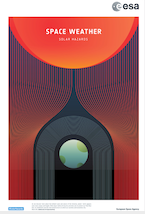Speaker
Description
The development of micro-particle detectors has a long history since the early years of the space age. Mostly dedicated to scientific purposes to gain and improve knowledge about the micrometeoroid environment around the Earth and in interplanetary space, their data was used to establish and enhance the respective particle environment models.
Due to the fact that in most cases these instruments were flown as piggy-back payloads and therefore limited in mass, power and volume, the detectors were built to measure impact properties of micro-particles, as otherwise no reasonable impact rates could be achieved.
Some drawbacks of the detection methods of existing detectors (e.g. GORID, DEBIE) led to the idea to investigate new detection technologies. etamax space and its partners from research institutes and industry started the development of AIDA, the Advanced Impact Detector Assembly. AIDA is a two stage detector, where the trajectory analyser stage measures the velocity vector of the incoming particle, while the impact stage determines its kinetic energy. Consequently, the most important particle parameters mass and velocity can be derived, which allows to discriminate between impacting micro-meteoroids and small space debris particles.
The AIDA trajectory analyser is based on four laser light sheets and sensitive photo-detectors, which allow to determine the position and the time-of-flight of the light flashes generated when a particle passes the light sheets. In the frame of the ESA activity “Particle Trajectory Analyser Phase A/B” a breadboard model of the instrument was developed and partly tested, bringing the instrument to TRL 4.
For the AIDA impact stage a new calorimetric detection principle was developed. The kinetic energy of the impacting particle is derived from the temperature rise caused in a small metallic plate when hit by the particle. The method was verified and a sensor calibration was performed at the Heidelberg dust accelerator. A full qualification of the impact stage was performed in the ESA activity “AIDA Impact Detector” and the instrument reached TRL 7 after some design changes and the respective delta-testing.
The presentation will outline the current development status and an overview of the instrument performances as well as the required resources will be given. For both the trajectory analyser and the impact stage development roadmaps will be presented.

